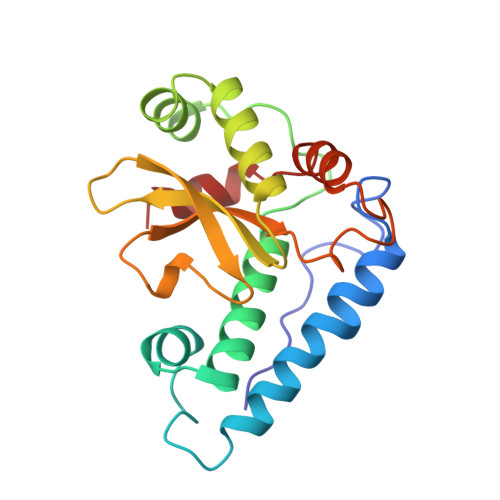Structure-function in Escherichia coli iron superoxide dismutase: comparisons with the manganese enzyme from Thermus thermophilus.
Lah, M.S., Dixon, M.M., Pattridge, K.A., Stallings, W.C., Fee, J.A., Ludwig, M.L.(1995) Biochemistry 34: 1646-1660
- PubMed: 7849024
- DOI: https://doi.org/10.1021/bi00005a021
- Primary Citation of Related Structures:
1ISA, 1ISB, 1ISC, 1MNG - PubMed Abstract:
The crystal structure of dimeric Fe(III) superoxide dismutase (SOD) from Escherichia coli (3006 protein atoms, 2 irons, and 281 solvents) has been refined to an R of 0.184 using all observed data between 40.0 and 1.85 A (34,879 reflections). Features of this structure are compared with the refined structure of MnSOD from Thermus thermophilus. The coordination geometry at the Fe site is distorted trigonal bipyramidal, with axial ligands His26 and solvent (proposed to be OH-), and in-plane ligands His73, Asp156, and His160. Reduction of crystals to the Fe(II) state does not result in significant changes in metal-ligand geometry (R = 0.188 for data between 40.0 and 1.80 A). The arrangement of iron ligands in Fe(II) and Fe(III)SOD closely matches the Mn coordination found in MnSOD from T. thermophilus [Ludwig, M.L., Metzger, A.L., Pattridge, K.A., & Stallings, W.C. (1991) J. Mol. Biol. 219, 335-358]. Structures of the Fe(III) azide (40.0-1.8 A, R = 0.186) and Mn(III) azide (20.0-1.8 A, R = 0.179) complexes, reported here, reveal azide bound as a sixth ligand with distorted octahedral geometry at the metal; the in-plane ligand-Fe-ligand and ligand-Mn-ligand angles change by 20-30 degrees to coordinate azide as a sixth ligand. However, the positions of the distal azide nitrogens are different in the FeSOD and MnSOD complexes. The geometries of the Fe(III), Fe(II), and Fe(III)-azide species suggest a reaction mechanism for superoxide dismutation in which the metal alternates between five- and six-coordination. A reaction scheme in which the ligated solvent acts as a proton acceptor in the first half-reaction [formation of Fe(II) and oxygen] is consistent with the pH dependence of the kinetic parameters and spectroscopic properties of Fe superoxide dismutase.
- Biophysics Research Division, University of Michigan, Ann Arbor 48109.
Organizational Affiliation:

















